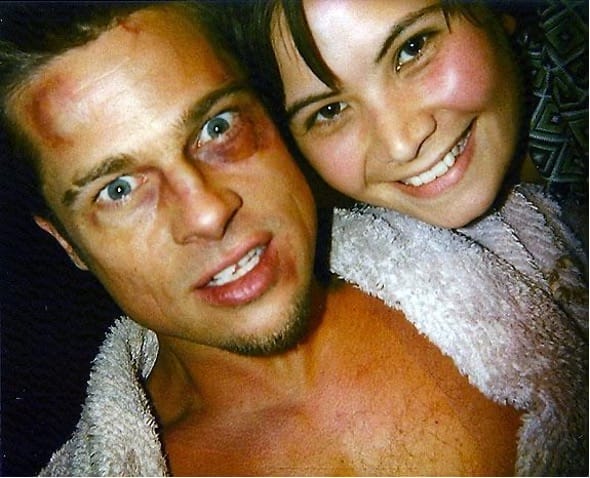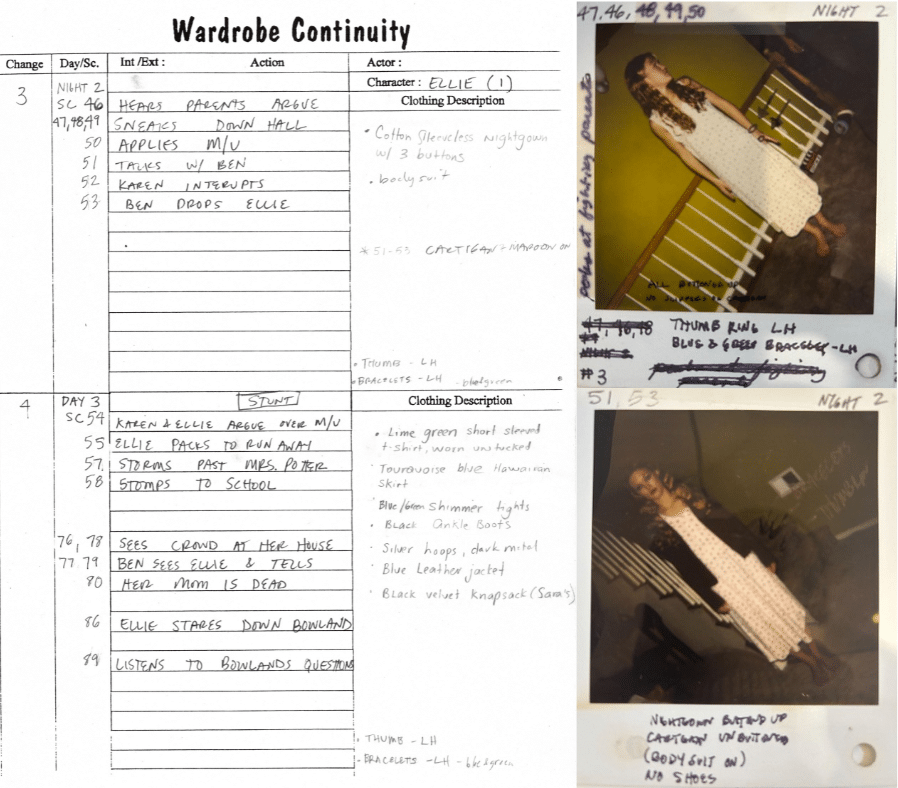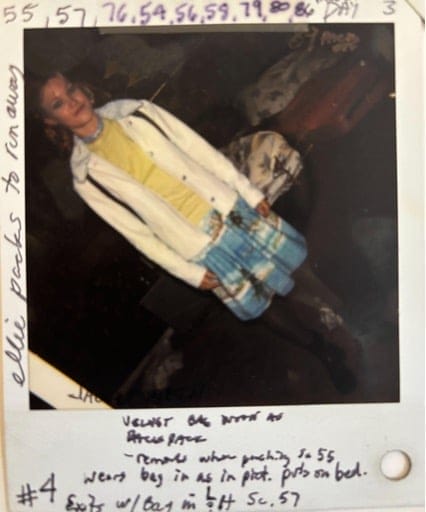I’ve done almost every job on a film set, from a day-player P.A. to directing and producing a short film. I’ve held an umbrella over the camera while getting soaked on a cold, rainy day in Chicago and wrangled a dog in a New York City park on a beautiful spring day. So trust me when I say that the most difficult job I’ve had on set is script supervisor (also called continuity). It’s one of the lesser known positions amongst the general public but no film or television set could function without a good scripty. It’s a conduit between production and post-production, the nexus of all information on the shoot.
The script supervisor has three main duties - ensure continuity, log every take with notes for the director and editor, and ensure everything in the script is captured during production. You’d be surprised how many times chunks of dialogue or crucial parts of story are forgotten about in the chaos of set life. The shooting log is essential for the editor and director, the notations of every variation in each take contributing to an efficient post-production process. And continuity? Well, remember when a Northern Ireland coffee shop got some unintentional product placement on Game of Thrones?

However, the best way to fully understand the work of a script supervisor is to take a deep dive and do a case study of an individual project. Luckily, we have a treasure trove of documents from Frank Beddor’s 1998 psychological thriller Wicked. This collection of notes and photos provides an excellent insight into life as a script supervisor.
The script supervisor on Wicked was Dina Waxman, a set life veteran who has worked with such directors as Michael Mann, Spike Jonze, Wong Kar Wai, and John Frankenheimer. She has written and directed seven short films and has served as a scripty on over one hundred commercials, two TV series, and 12 films, including David Fincher’s iconic 1999 action thriller Fight Club starring Brad Pitt.


On Wicked, Waxman worked closely with costume designer Sara Jane Slotnick (Alpha Dog, Loving) and wardrobe supervisor Jim Hansen (Kill Bill Vol. 1 and Vol. 2) to produce a thoroughly detailed catalog of each actor’s wardrobe pieces for every day of shooting. From more general items like the types of outfits or the number of wardrobe changes to the more minuscule details such as if an actor’s wearing any jewelry or the way their shirt tucks into their pants. It is all noted, photographed, and indexed. It is a painstaking amount of work and requires a mind that is simultaneously able to hold both the minute and larger picture in equal importance at the same time.
There are a few reasons why this obsessive level of detail is required. Scenes will often be shot out of sequence and your director and cinematographer may choose to start with the end of the scene rather than the beginning or return to a scene later in production or during reshoots. You will also need to reset for each take and each time the camera moves. The actor’s costume needs to be the same as the other shots because if you have a shot where your actor's sleeve is up and that sleeve down in the next angle, your film is going to look pretty amateurish. Your editor and director need shots that link up to produce a cohesive cut.


The Wardrobe Continuity log above contains all the information needed to identify what is being shot. It lists the shooting day, the scenes being shot, what is happening in those scenes, and what the actor, in this case Julia Stiles, who won Best Actress at the Karlovy Vary International Film Festival for playing Ellie, wears in those scenes. This is designed so costume, props, camera, anybody, can take a quick look and get all the information they need. On the flip side of that document are polaroids of the actor in those costumes, giving the crew a visual they can match when resetting the scene. Quick note about the photos, script supervising can sometimes seem like you’re shooting behind-the-scenes content. You will take so many photos. You’ll think to yourself, “Am I taking too many photos?” and then realize you haven’t taken nearly enough. Thankfully, in 2024, scriptys use their phones so there aren’t any polaroids to come unstuck and slip out of the binder.
The scenes chronicled above call for Ellie (Julia Stiles) to wear a “cotton sleeveless nightgown” in Scenes 47-50 with a cardigan over it for Scenes 51-53. In the first polaroid, it’s noted that the nightgown is buttoned up and Stiles is wearing a ring on her left thumb and a blue and green bracelet on her left wrist. Those items are also marked on the photo itself. The second photo, where Julia Stiles is wearing the cardigan, also notes the placement of the ring and bracelet, even though you can’t see the jewelry because of the sweater’s sleeve. Why does the actor have to wear the ring and bracelet even if you can’t see them? Because, during the time frame in which these scenes take place, it wouldn’t be realistic for the character to have removed her jewelry. So if she lifts her arm during the scene and the sleeve falls down, the audience will notice she’s missing her ring and bracelet from the previous scene. This would take them out of the story and threaten to compromise their ability to suspend their disbelief, which is essential in any type of film viewing, but especially with Wicked.
For the third polaroid, the most important element is that Stiles will be wearing the same outfit in nonsequential scenes. The scenes take place during different times of the day and in a few different locations. If she got changed during lunch or they shot a different scene in the afternoon that required a wardrobe change, this snapshot ensures that the costume department can get her back into wardrobe quickly, efficiently, and accurately. This leads to a smoother set where the cast and crew can fully focus on character and story instead of the location of the main character’s turquoise blue Hawaiin.

You’ll notice that the log above contains much less information than the one shown in the previous section. However, the scenes represented here are infinitely more complex. Why? Well, if you guessed the blood, you’re absolutely correct. Blood and gore are super fun to work with but it’s a complicated, stressful business. First, there are the safety considerations. The fact that blood is being used on set generally means the actor or stunt double will be required to perform a stunt involving violence. In Wicked, for example, this sequence called for Ellie to be struck in the head with a heavy object and for Lawson Smith (Patrick Muldoon of Starship Troopers and Melrose Place). The safety of the individuals involved in the stunts is paramount and a lot of effort and concentration from everyone on the crew goes into making sure they’re safe.
The second reason special effects work such as blood can be challenging for crews is because blood is a continuity nightmare. How do you ensure the blood on the set and the blood on the actor’s costume match angle to angle, take to take? The answer - lots and lots of pictures. The pictures above are essential to ensuring continuity with lots of moving parts that usually require multiple setups to capture. The first photo would’ve been taken either before or after the camera started rolling so the crew could match their positioning and the amount and placement of blood when setting up another shot. The second photo specifies the blood droplets on Stiles’ shirt, allowing the crew to ensure they can replicate the pattern if they need a new top. The third polaroid specifies the position of Stiles’ clothing in a specific shot so the crew can once again match that look in subsequent set-ups. Working with special effects often makes for a high-pressure environment given the lost time and higher costs that can be a consequence of a mistake, so the script supervisor needs to be flawless in their documentation.
The position of script supervisor is a multi-faceted, sometimes stressful position that requires constant communication with every department. For a film like Wicked, requiring several specific costumes and detailed special effects work, Dina Waxman’s work contributed to an efficient set, allowing the actors and directors to craft an engrossing thriller that captivated audiences at Sundance and launched Julia Stiles’ career.
You can watch Julie Stiles’ breakthrough performance in Wicked on the following streaming platforms: Amazon, YouTube, Apple TV, Google Play, Vudu, Plex, and Tubi.

An itinerant storyteller, John Drain attended the University of Edinburgh before studying film at DePaul University in Chicago and later earned an MFA in Screenwriting from the American Film Institute Conservatory. John focuses on writing mysteries and thrillers featuring characters who are thrown into the deep end of the pool and struggle to just keep their heads above water. His work has been recognized by the Academy Nicholls Fellowship, the Austin Film Festival, ScreenCraft, Cinestory, and the Montreal Independent Film Festival. In a previous life, John created and produced theme park attractions across the globe for a wide variety of audiences. John keeps busy in his spare time with three Dungeons and Dragons campaigns and a seemingly never-ending stack of medieval history books.